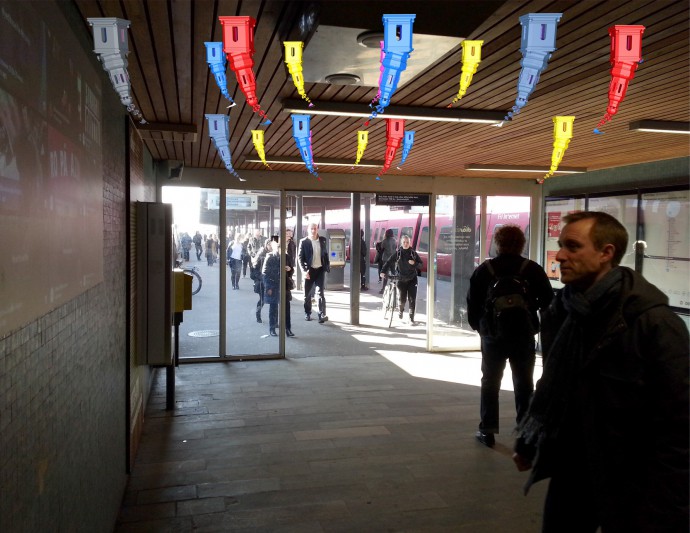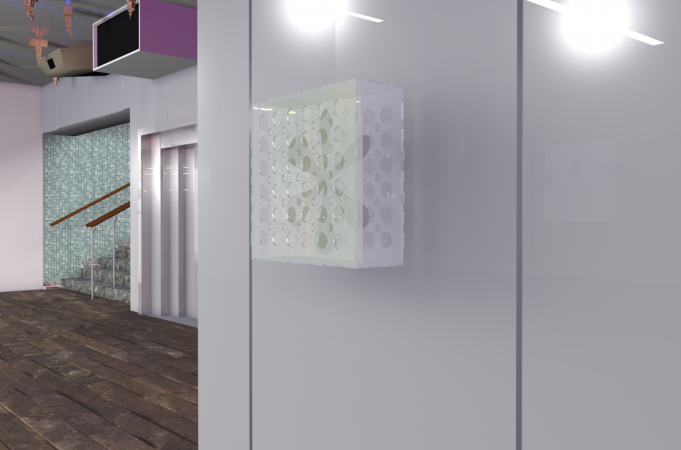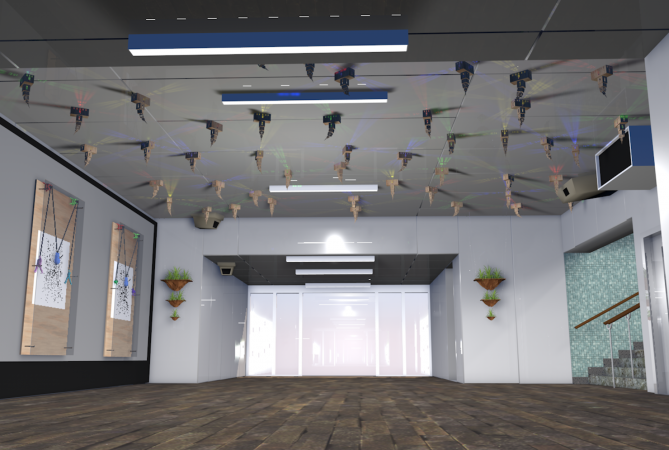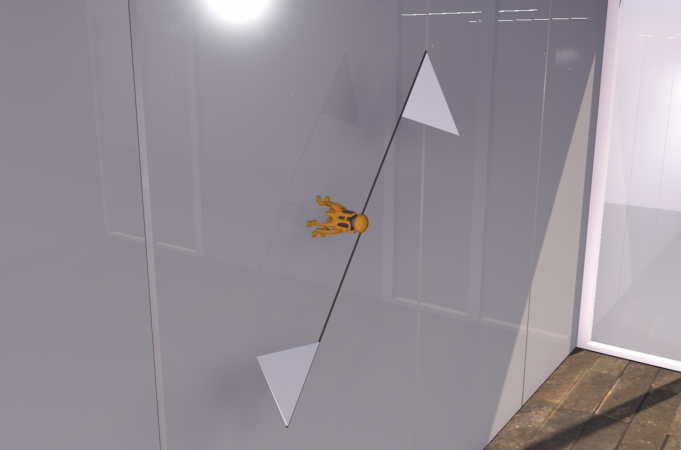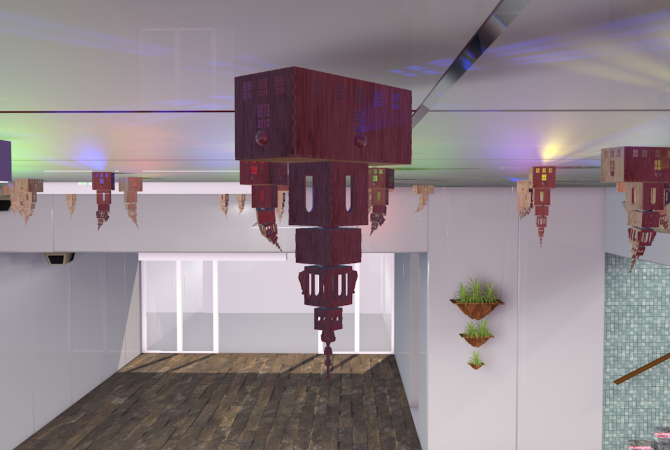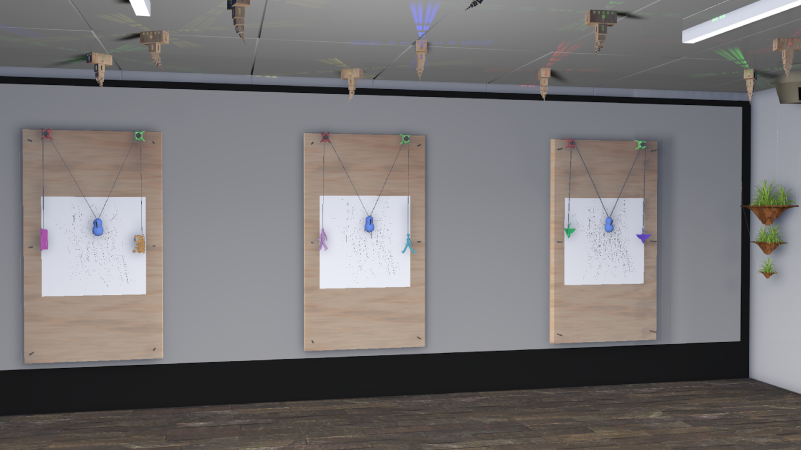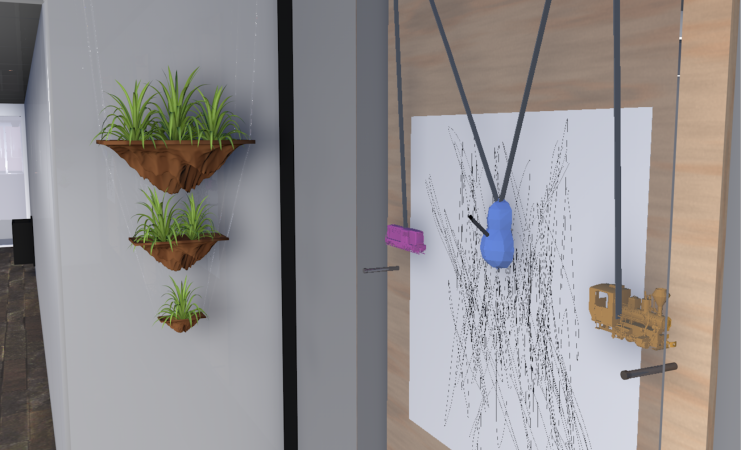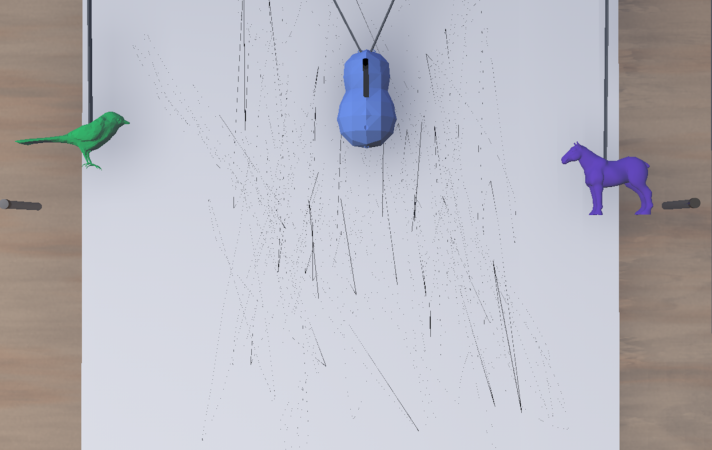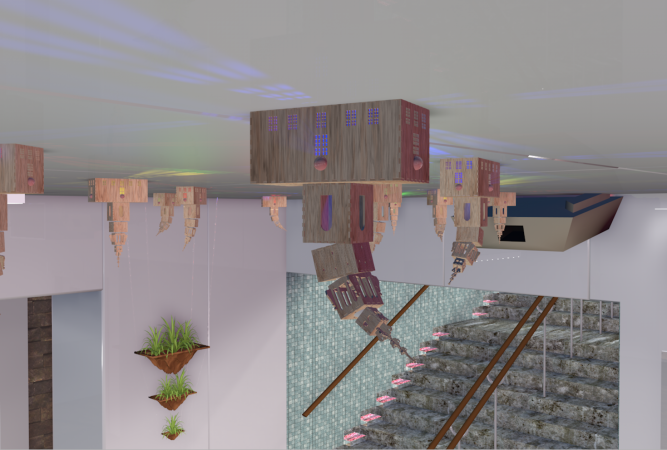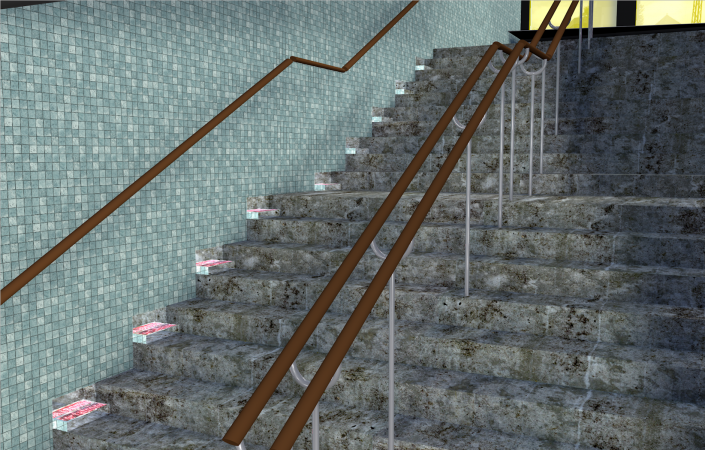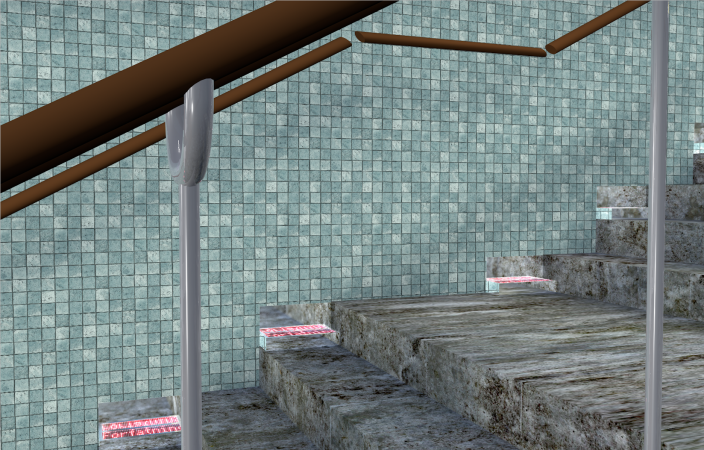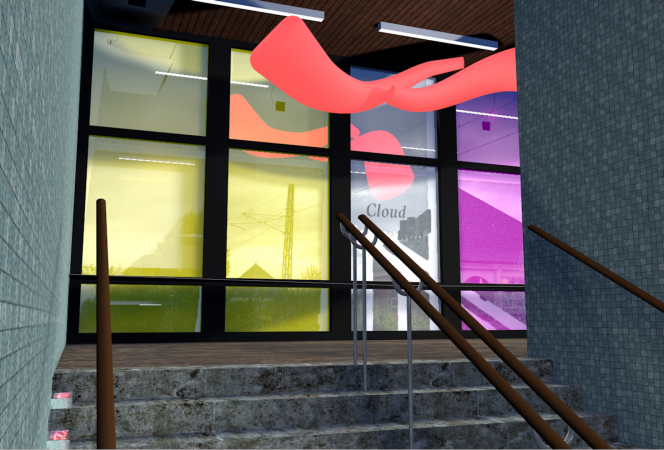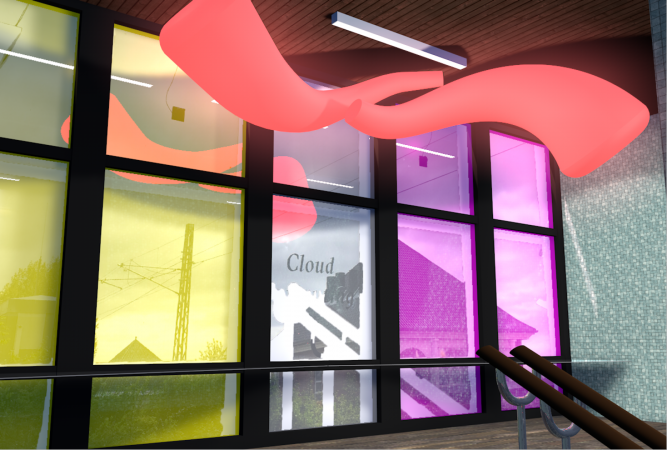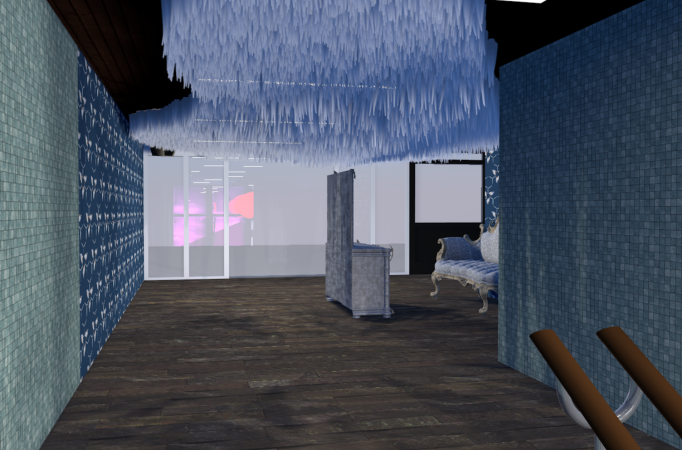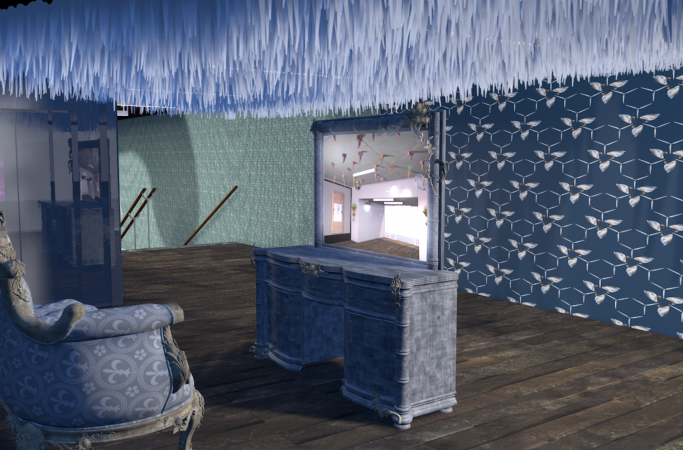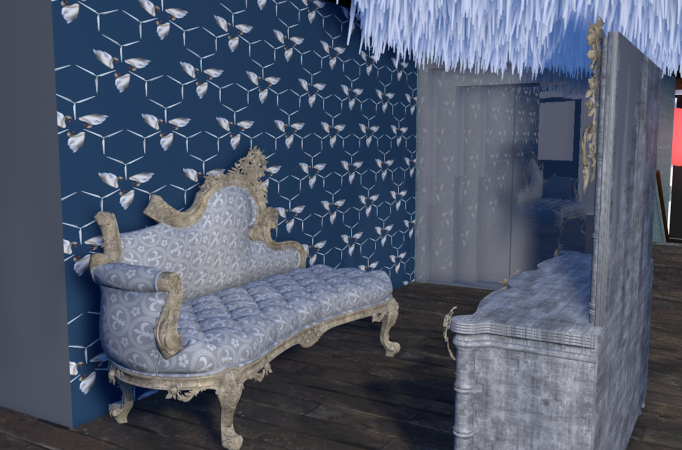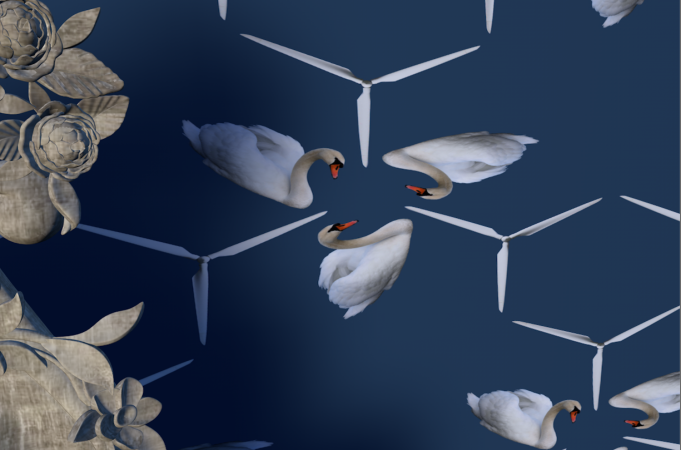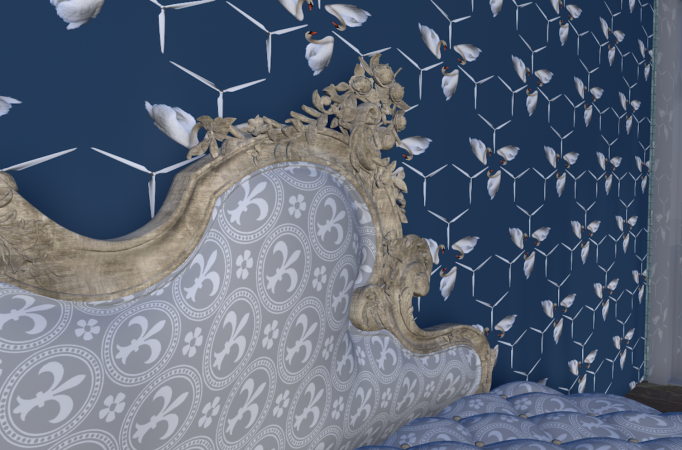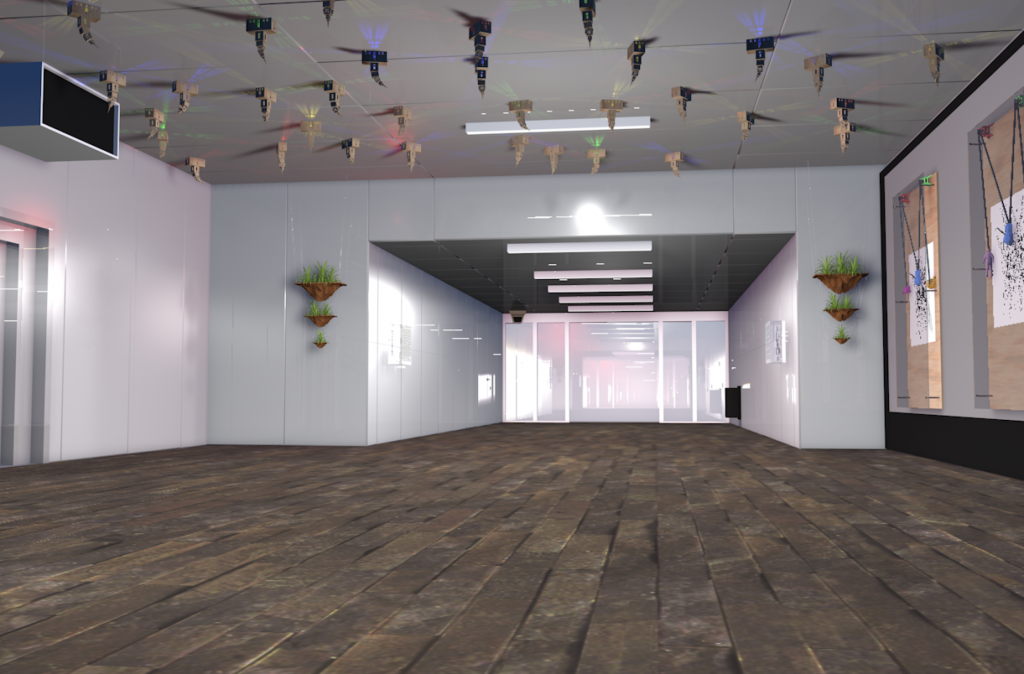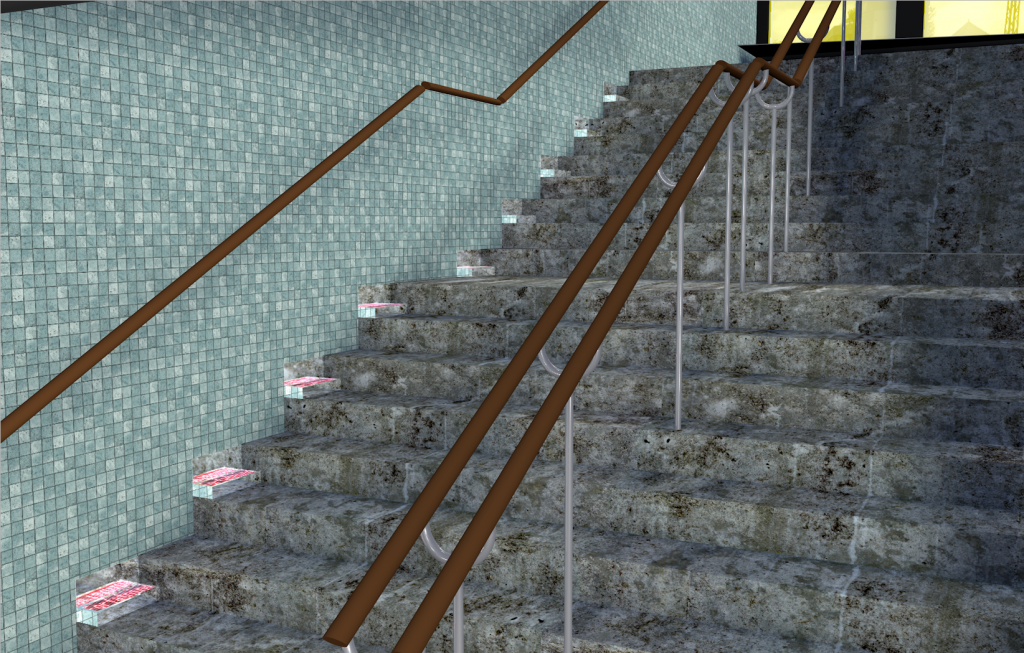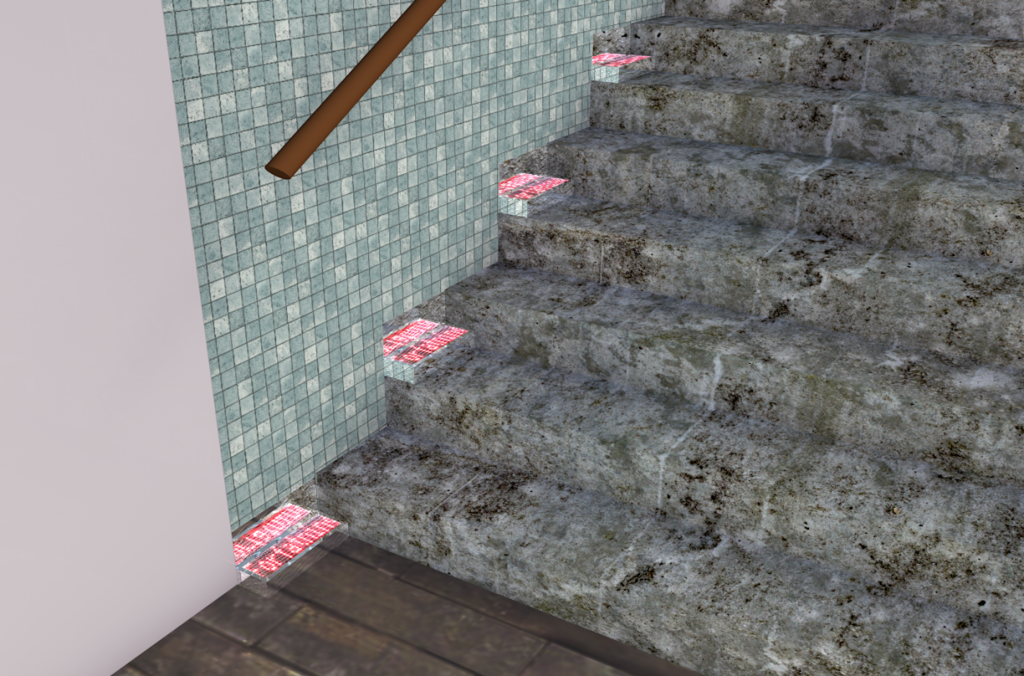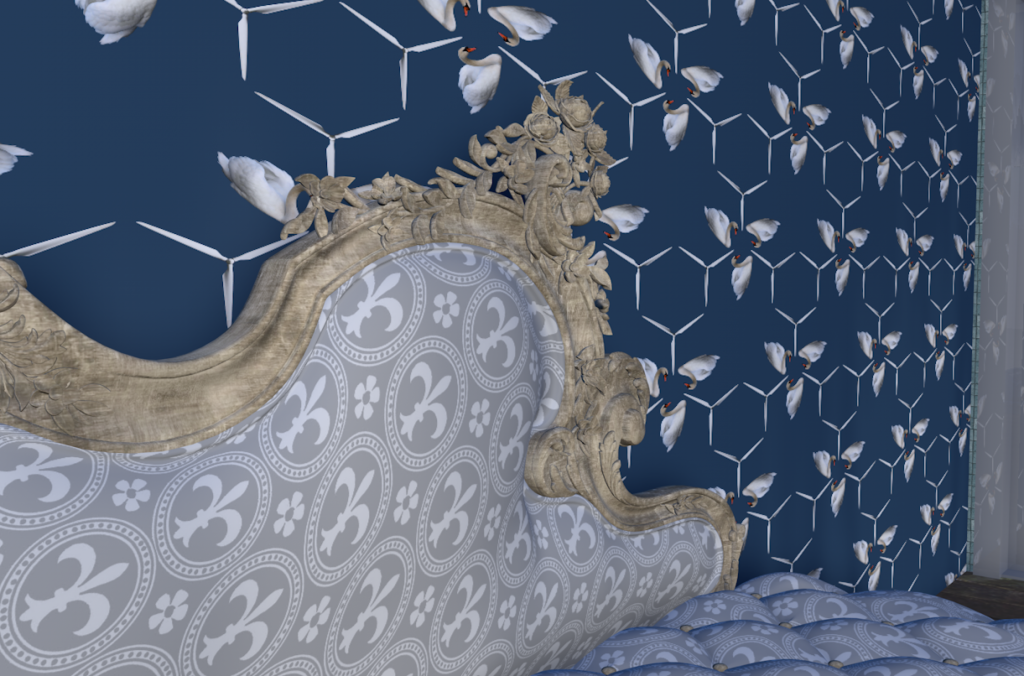As tools have morphed into machines, empowering a seamless melt into information and data spaces with computers, governance has also evolved. Christiansborg Palace and the government building on the islet of Slotholmen in central Copenhagen, Denmark, are the beginning inspirations for the artificial life installation C / Borg – The Parliament of Robots.
The present Christiansborg Palace is the last in a series of successive castles and palaces constructed on the site since the construction of the first castle in 1167. Since the fifteenth century, this building has evolved and now serves as the base of the central Danish administration. Until 1794 it was the principal residence of the Danish kings and, since 1849, has acted as the seat of Parliament, the seat of the Minister’s office, and the Supreme Court of Denmark.
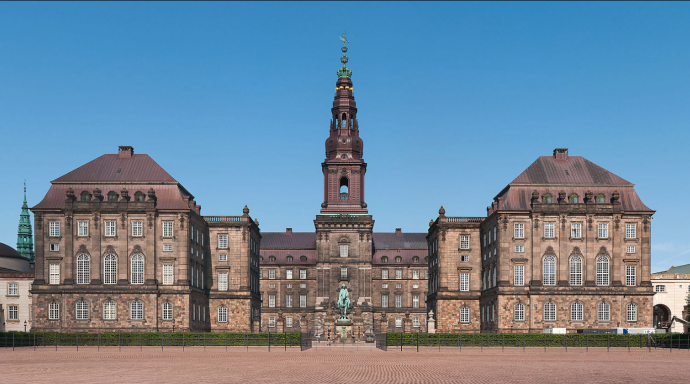
I admire Denmark’s architecture and governance on many levels as an artist. First, from a country such as the US, where many feel our government is unresponsive to the people, I am drawn to this royal palace and how it iconically represents an ideal of a government that sees, provides for, and responds to the people.
The evolution of the palace from the king’s castle/home to the seat of administration and how the various styles of architecture reflect distinct eras of Danish architecture and governance. Fires and politics have also been central to the formation of its current architectural statement, as the evolution of any management is related to time and, sometimes, chance happenings. The first fire in 1794 and the second in 1884 influenced the castle and its current architecture.
The fires also parallel Denmark’s civil, organizational, and institutional evolution, and as such, the architecture of Christiansborg Palace is a living and evolving structure. The current Palace finished in 1928 in a Neo-Baroque style, is remarkable. The chapel, completed in 1826 in a neoclassical style, also adds to the layers-in-time expression of this work of architecture and Denmark’s political evolution.
The palace is a symbol and a vibrant living structure serving the people.
To an outsider, especially from the US, where income inequality is high, Denmark looks ideal: a country with open education and universal healthcare. As a leader in wind development and a daily bike rider, I admire bikes’ central role in everyday life and follow websites like Cargo Bike Nation; http://www.copenhagenize.com/2015/10/cargo-bike-nation-copenhagen.html.
While researching and working on this installation, I learned more about my Danish roots. My great-grandmother Mabel and great Grandfather Nils came from Denmark in the 1880s. Their name was Stohl, and changed to Steel at Ellis Island in NY. An uneducated man, he was good with his hands and built the family home in Sparta, Wisconsin supporting his five kids with blacksmithing and handyman jobs.
The family was so poor my grandmother wore clothing made of flour sacks. These sacks were a leftover from the large quantities of flour my great-grandmother used to make bread for the family. My grandmother Lila, perhaps, as a result, was fashion conscious and could hardly wait to leave Sparta for Milwaukee, where she met my grandfather Hugh (Scottish) and where my mother Ann was born.
C / Borg – Parliament of Robots at DIAS Digital Interactive Art Space, invited by chief curator Morten Søndergaard and director of DIAS Rasmus Vestergaard, will consist of interactive robotic sculptures inspired by the culture, nature, and political organization of Denmark and its relation to an evolving global politic of robots and machine vision.
As devices and critical information infrastructures and their algorithms are increasingly used to navigate the constructed and the virtual world, as well as our natural world, questions arise about how they structure our relationships to the biological living systems that support us.
Given their epistemological tendencies to simplify the world with a reductionist code, could robots show sensitivity to natural living systems? How do robots influence and structure ideas about our planet and its future? Do robots and computers amplify or diminish life, and can living systems find a symbiotic intertwining and coevolved coupling within the technological infrastructures that are now part of what appears to be the rapid movement toward autonomous machine replication?
As all life, including code-based computer artificial life, is foundational and dependent on natural living systems, this installation will create hybrids and composite organisms, where machine, nature, and station and its living traveling participants will coexist within an artificial life art ecosystem, integrating computer and natural systems.
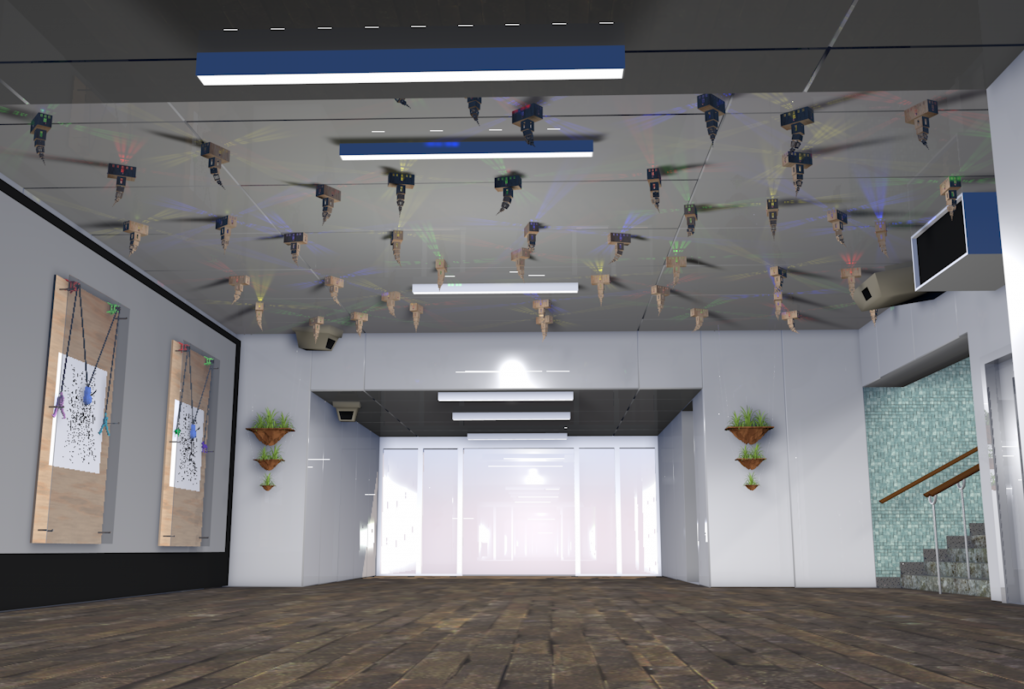
These artificial life robots inspired by Christiansborg Palace will hang from the ceiling of the station like the caring fingers of a sea anemone. They will function as Robot Folketing / Parliament of Robots responding to individuals as legislation and governance respond to the people’s will.
The constitution requires equal representation of the various opinions of the electorate. These robots will also collectively respond to one and many individuals as the metaphor for this extreme example of representational government. The Danish political system is characterized by a fusion of powers with the government drawn from the ranks of the Folketing.
These fingers will respond when viewers pass. One robot will influence another robot as they are first visually activated with RGB LED colors and motion.
Some of the C / Borg – The Parliament of Robots will be given birth on laser cutters in natural wood and will allow replication of large numbers to fill the station with this living sculpture. Each robot will be about 40 – centimeters long. They will be placed in the station to be out of the easy reach of passing viewers.
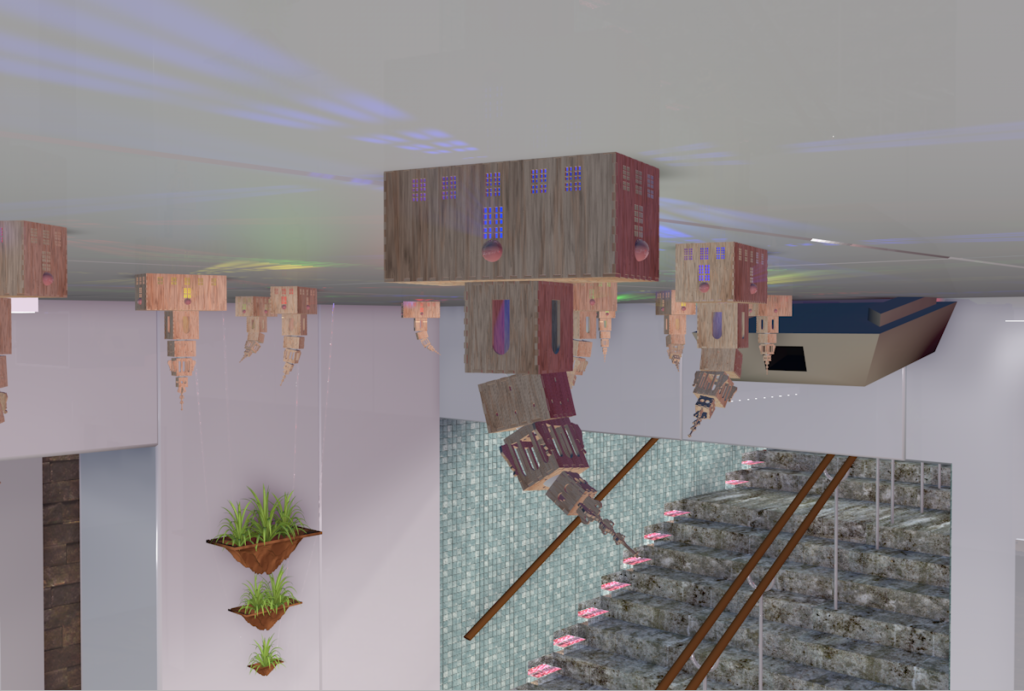
The laser-cut and constructed robotic buildings have Christiansborg Palace as an iconic point of departure and conflate contemporary architectonic forms with a totemic automated form. They further play with potentials afforded in the process of making and sculpting with lasers and code-based replication with the machine’s logic and its nature tends to influence.
Motor and upside-down test to see motor speed and motion.

High brightness RGB led test.
Data / Site / Interaction
Varieties of drawing robots will capture and create drawings resulting from humans walking and interacting with one drawing robot. Another drawing robot will capture the sounds of the train and whistle and translate that into a picture. Outside the station, microphones will capture birds chirping and other natural elements near the station, allowing a third drawing robot to make drawings based on these sounds.
Collecting this original data through the interaction of passing passengers will affect the analog accretive drawing outputs and create semi-organized and chaotic designs.
These will hang on the walls at the main entrance and keep an abstract count of humans, machines, and nature.
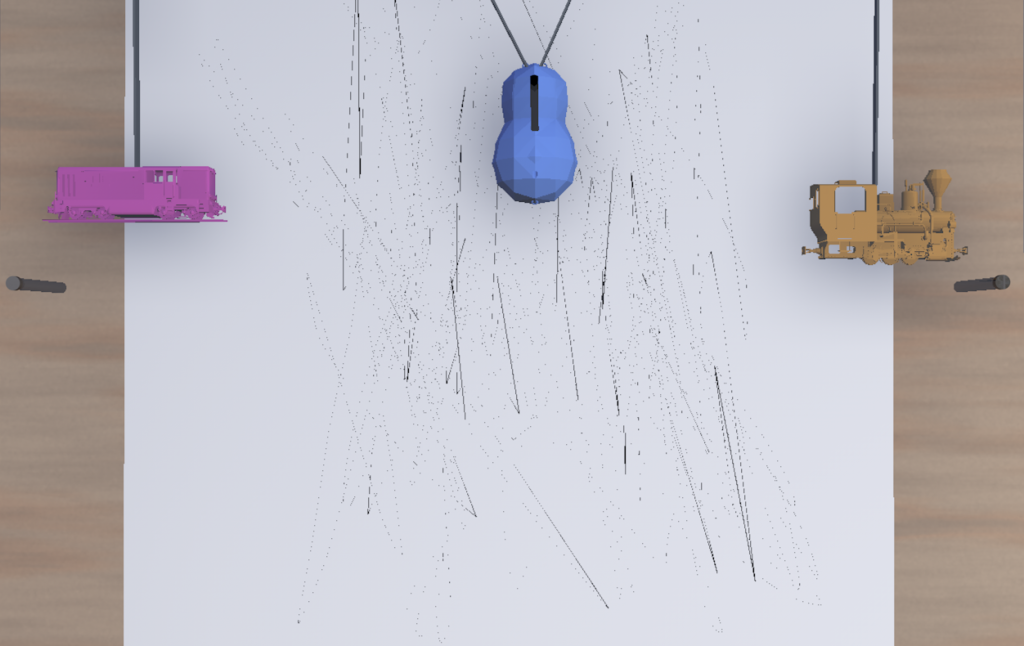
Pens with large storage tanks will be used. As the plexiglass and sheets of plywood for this work are sourced in Denmark, and the motor hangers and clips are lightweight, this work travels with low dimensional and physical weight.
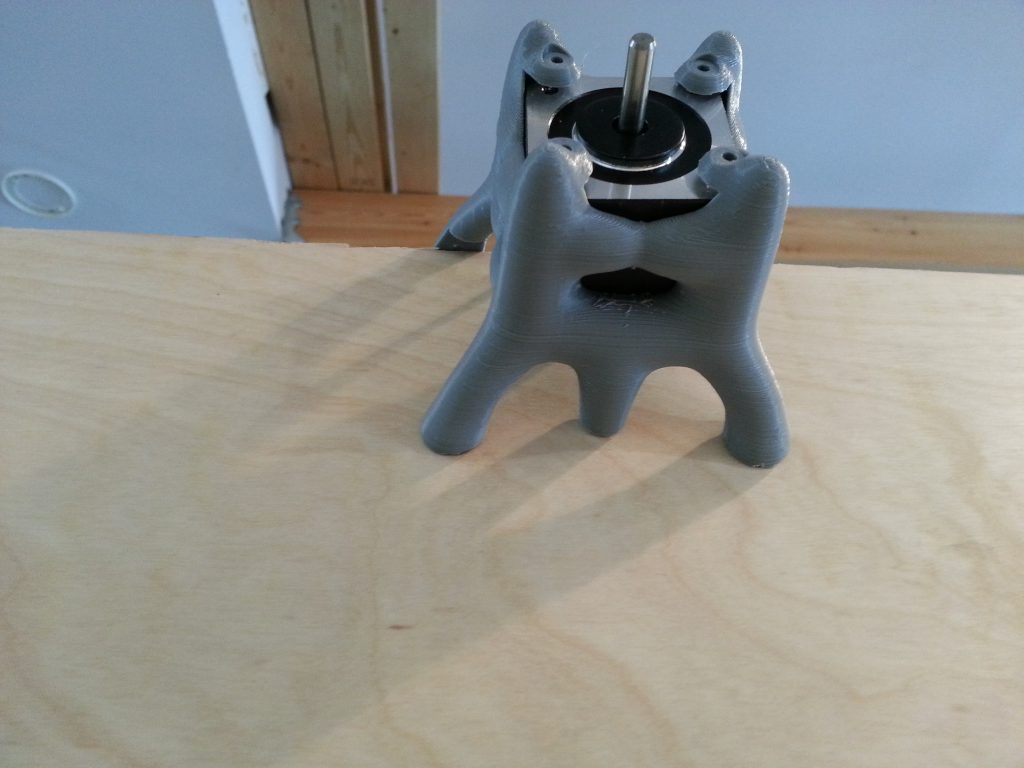
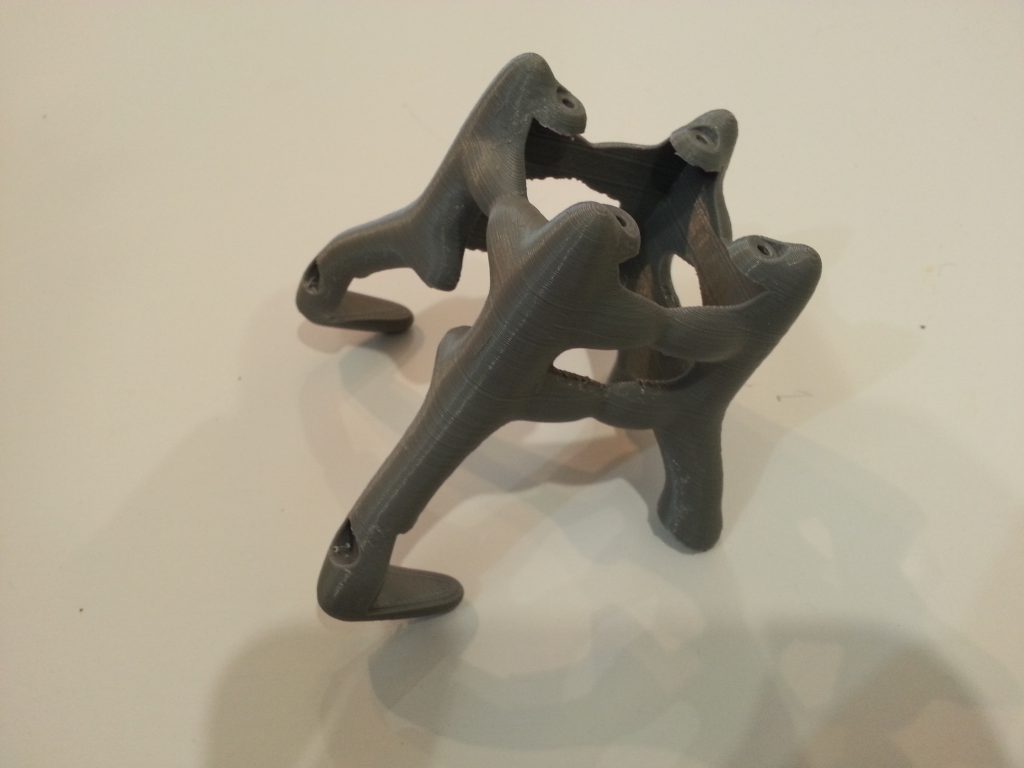
Accretion bio and data work that both filters and collects human DNA dust, pollen, bacteria, and all-natural and artificial spores and gasses that flow through the station. The fan will reveal the image over time as the filter will collect the dust only in the pattern of the laser-cut filter material.

I envision these filter sculptures near the parking lot where human and animal cellular dust, pollen, bacteria, fungi, and car particulates will all come together in this composite. The resulting print that is left will be a kind of passive collaborative collecting of human DNA and other natural particulates along with the signatures of our age, which are trace machine particulates.
The works will leave an imagistic core sample of that time slice in the urban bio/machinic particle mix, revealing the drawing over time.
Danish texts constitutional/poetic
9-15 LED text-based works ascending the stairs will display constitutional text elements: scrolling. Danish philosophies/ current discussions may also be streamed live if feasible.
The works will be encased in diamond plate steel or aluminum, with a reflective quality that will shimmer and have reflectance along the stairs allowing the text to be seen in reverse and shattered by the lensing of the diamond plate.
The effect is relevant to the evolution and cascading of ideas in time, as the words are recreated in these miniature technological lenses. The moving LEDs will also act as beacons and lighting along stairs, opposite the bike ramp on the other side.
Concerns for the placement of these works is the method of cleaning the station. Do they hose down the floor, for example? The boxes can be sealed and watertight.
Messages to travelers
An expandable Lycra Intertwining LUR sculpture will change light based on the arrival and departure of the trains. While the form is inspired by the LUR, they will be placed in the mid-landing of the station. They will also be a signal to viewers signaling with sound/light as trains arrive.
On the windows, the colored film is yellow on the left and pink on the right. Laser-cut plastic mirrored surfaces will be placed along the window to reflect trains and the sky on the lower window sill. The windows will also remember the Intertwining Lur more and less as darkness falls.
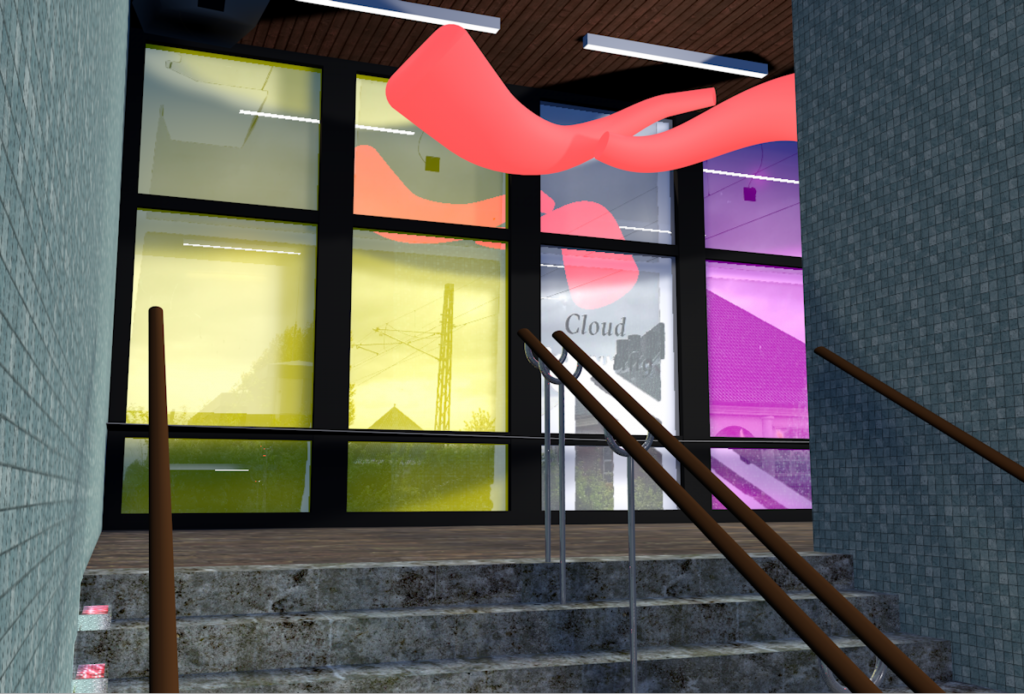
Semaphores / Machine Sonification / Emotion
Varieties of semaphore robots are being explored. Potentially hanging from the walls at the entrance or near the stairs landing, these semaphore-inspired works will signal the future of our planet. These will be networked, at times working in synchrony and at times doing individual dances/spinning.
They will have flowing soft elements with printed silk images to capture the robots’ motion and wind through space as the station doors open and close. Patterns of material flowing about stepper activation will be further explored.
The stepper motors also make exciting sounds, and I may use that sound as part of the aesthetic of this portion of the C / Borg – Parliament of Robots.
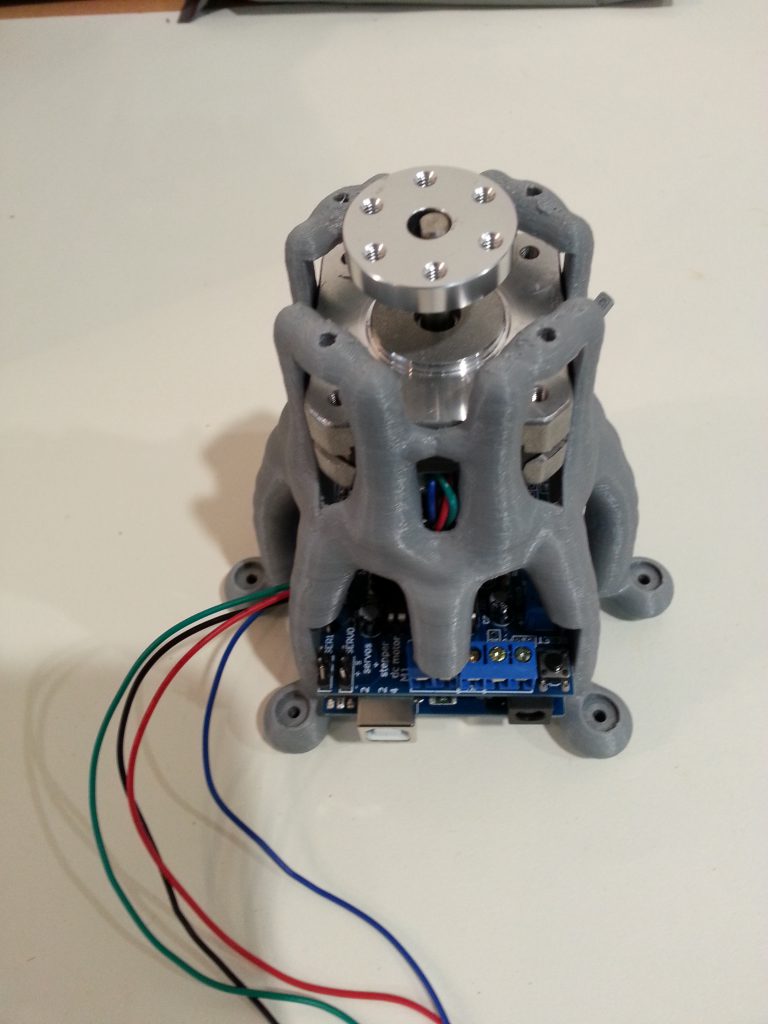
VR / Where artists invent the future
Since Denmark was the first country I was able to realize a crowdsourced project at Aalborg University with the invitation of chief curator/researcher/professor Morten Søndergaard and artist/professor Laura Beloff, I will also be envisioning a future within the physical station that is a virtual recreation of the station.
However, when you exit the station virtually in this VR work (viewed while sitting on a rococo couch), you will be entering a proposed future scenario of Copenhagen and the planet broadly. Invited artists and futurists will construct and imagine “the future” with virtual rooms. By exiting the virtual station doors, you would, in essence, be entering a kind of collective imagination of the artists. The proposed VR works may be concerned with environmentalism or politicking. However, artists may also show the potential for exploring a creation that may only be accessed through a VR experience.
Once proposed to me and the curator, all 3D assets for the VR would be created by my students who study 3D modeling and then brought into the Unity Game Engine. Students may be able to receive credit for an internship.
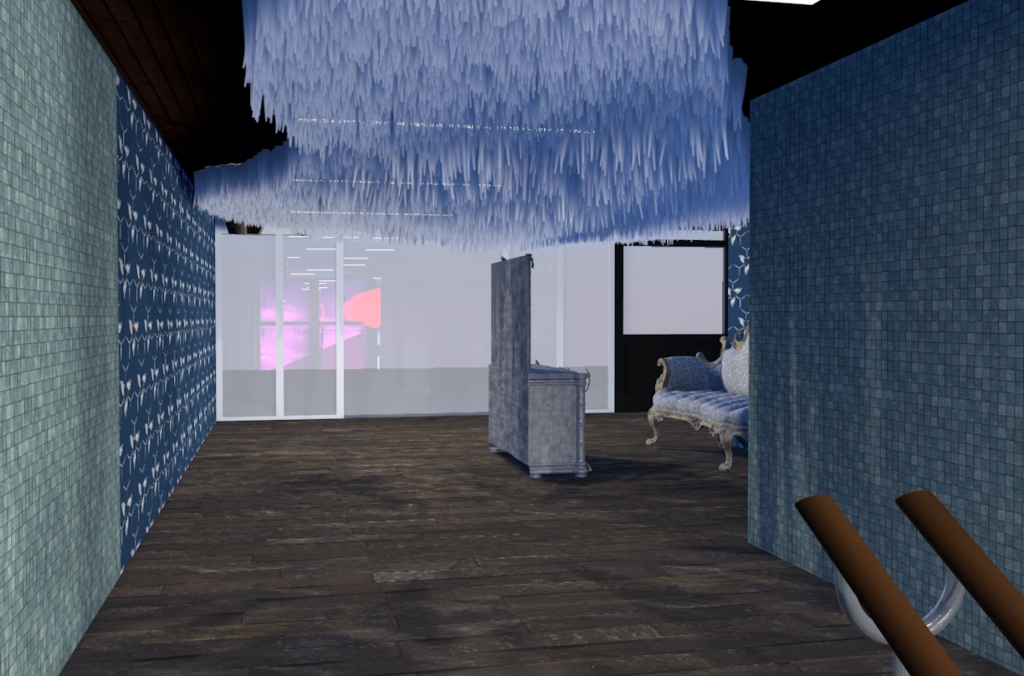
This VR work will be viewed from the Queen and King’s lounge, where a rococo couch and nearby joystick allow navigation through the virtual world being displayed on the large flat screen tv set in the place where the mirror of the dresser would be.
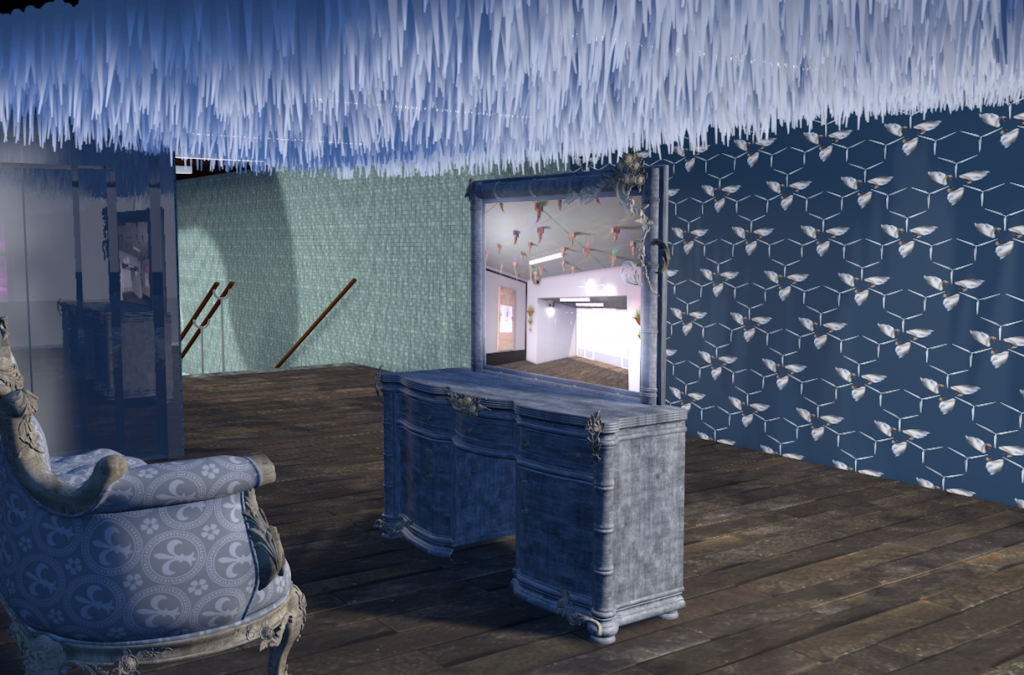
The white plastic installation above may blow in the wind as the double doors open and close for trains.
If these kinetic elements are approved and feasible, they will be constructed by artist Dana Lynne Harper. They would enter the exhibition as an invited collaborative work, given the design will be by both Rinaldo and Harper. This proposed element cannot impede line-of-sight emergency signage, which is one primary consideration for this work’s placement and/or approval.
This work would be constructed with wire mesh and fire-resistant plastic tape and would be lite-weight for shipping.
The wallpaper will be fabricated with alternating wind vanes from industrial wind farms and the Mute Swan.
The rococo couch, dresser, and TV will be sourced locally in Denmark.
Existing couches may be modified using rapid prototyping plastic where ornate elements are needed.
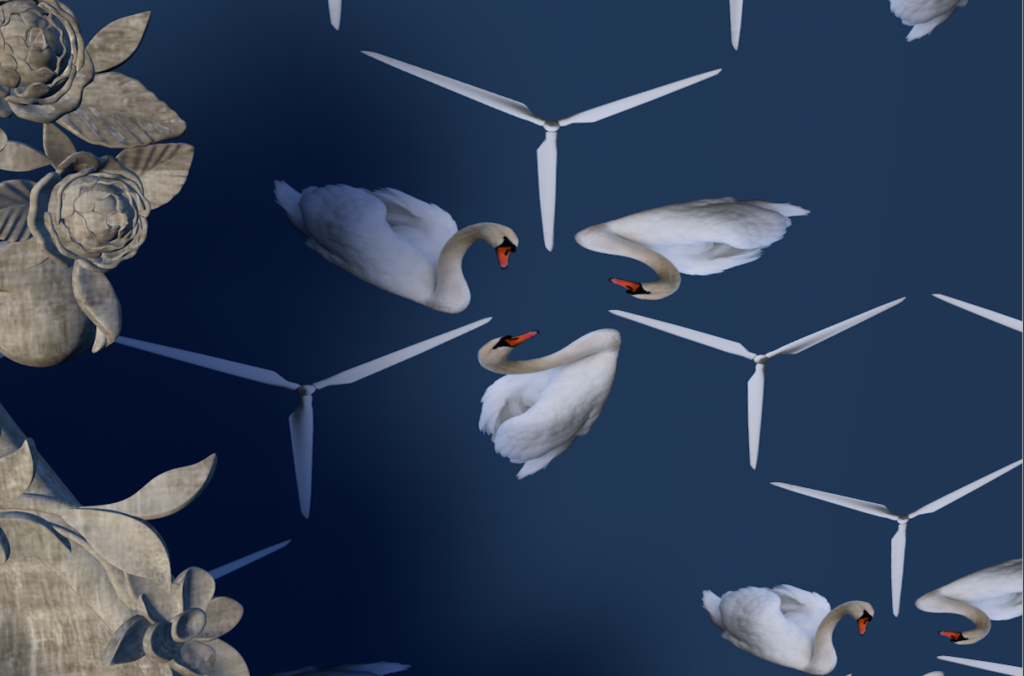
This proposed VR work will create a national and international dialogue about education and government and the function of artists, researchers, and citizens in creating their ideal world, especially with machines and advanced electronic and mechanical control technologies. Artists and creative folks are generally adept at evolving technologies, especially when unconstrained by market forces. The manifestation of the virtual Copenhagen and virtual will be an exciting adventure of collaboration and visualization.
In this virtual space, we may see the mini fruit fly printers of Laura Beloff and the green worm reprocessing worlds of artist Amy Youngs and sound installations by TradeMark Gunderson. These elements of the work will allow a genuinely international dialogue between the collective brain trust of Denmark and a planet of thinkers, makers, and terraformers — a discussion about the function of the arts and government in the evolution of contemporary culture and evolving governance.
This element of the exhibition will be subject to how the budget goes.
The Politics of the Machines – Art and After
Chief curator Morten Søndergaard and artist/professor Laura Beloff will be hosting an international conference at the same time as the premiere of this work.
The POLITICS OF THE MACHINES – ART AND AFTER EVA-Copenhagen 2018 will occur concurrently with the opening of C / Borg – The Parliament of Robots.
Living Systems/machine gestures
Several slow-growing, hanging planters fabricated from rapid prototyping processes will host epiphytes (air plants) and local mosses of Denmark; blad Mosser; hepatopsida, anthoceratopsida, spagnopsida, andreaseopsida and electronic monitoring and watering is in research. These may be cast in terra-cotta.
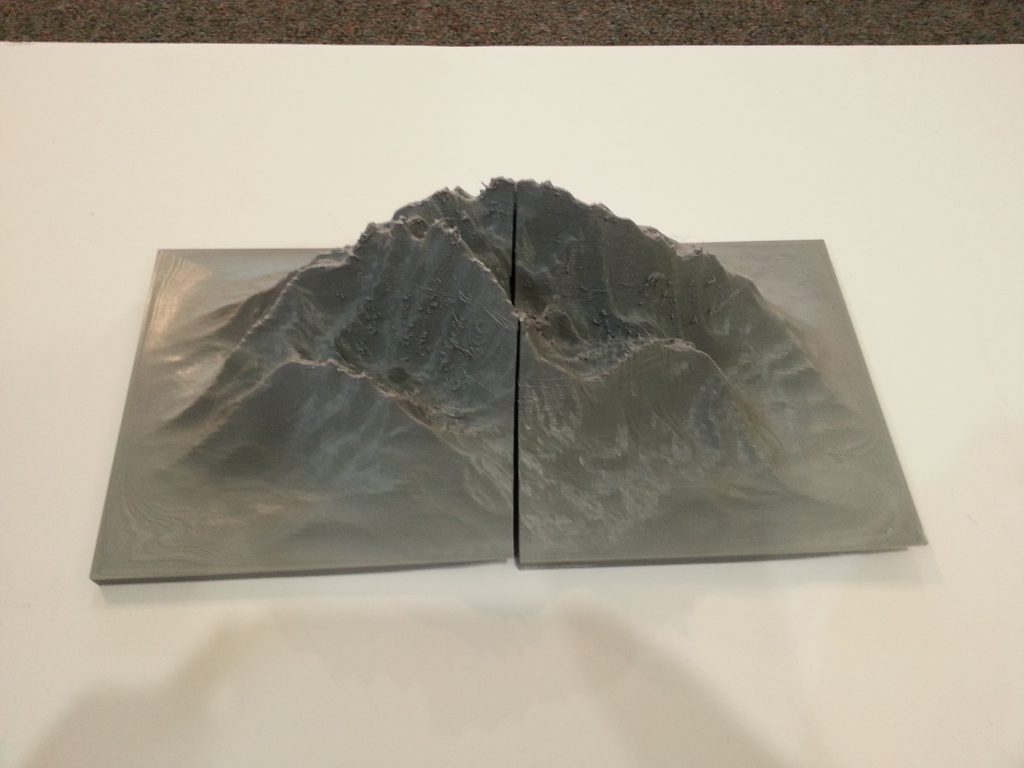
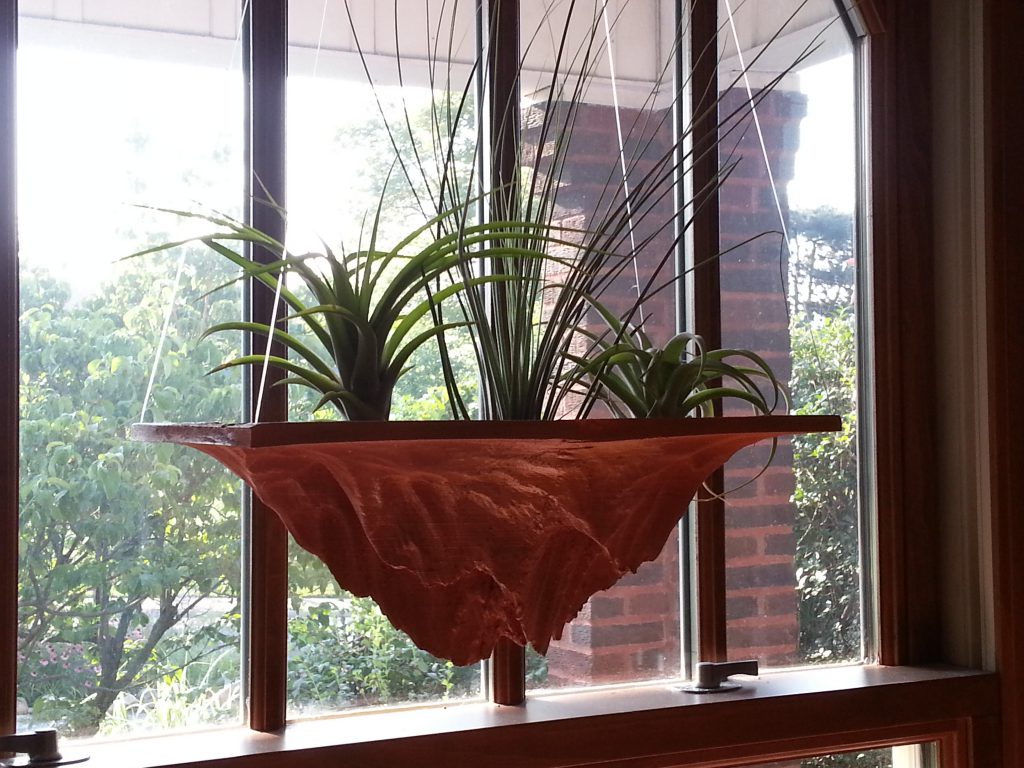
Electronics / sensing / actuation
The works will be robotized with Arduino microcontrollers, XBee and Zigbee networking, motor shields, and Arduino programming. Passive infrared sensors within each robotic palace allow them to be responsive to passing viewers as they move through the station. Motor shields designed for DC gearhead motors and/or stepper motors will be utilized to drive the C / Borg bots.
Power supplies will reside near embedded hanging planters holding epiphytes and mosses of Denmark and bring 12-volt DC (Direct Current) to each robot.
That voltage will also be regulated to 5 volts to supply the Arduino microcontrollers. The robots will be using low power and therefore be energy efficient. As the C / Borg robots will only move when viewers pass through the station, they will otherwise be at rest, adding to their functioning longevity.
Custom-designed and laser-cut Scotch yoke mechanical devices are being developed for fail-safe motor actuation of monofilament pull strings that will run through the robotic palace structures for movement in response to sensor activation.
Four passive infrared sensors placed around each robot will give eight quadrants of sensing and actuation toward human body heat. As most human body heat comes from the head, the sensors are responsive to even the slightest movement.
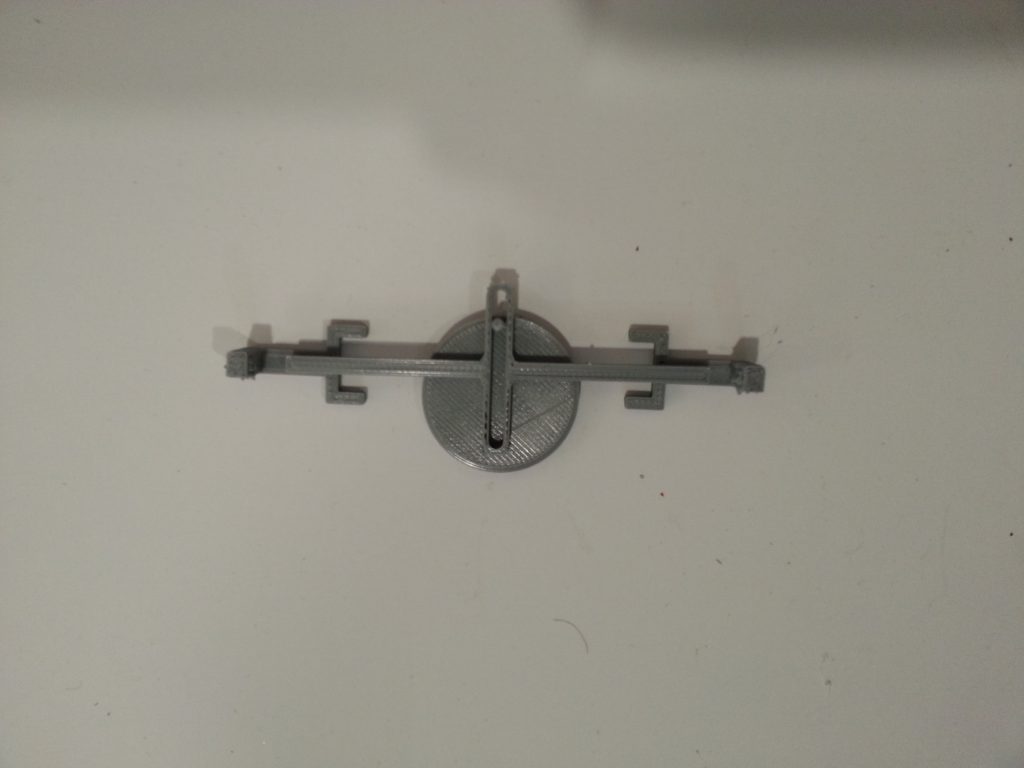
Software / Behavior / Misbehavior / Mesh Networks
The software is a variant of the subsumption architecture of MIT. It will allow a distributed flocking behavior based on emergent behaviors of the robots reacting to the human presence and reacting and interacting with each other.
They will emerge in this process. Emergence can be described as individual elements emerging into an organic whole through the interactions of localized sensing and actuation behaviors.
All robots will move toward the body heat of humans moving through space. The robots will also respond to each other with a distributed mesh network of sensors and actuators, so the individual robots will form a large a-life robotic organism.
One moving C / Borg bot will cause a cascade of other C / Borg bots to move and respond in like manner, given humans’ proximity to the robots.
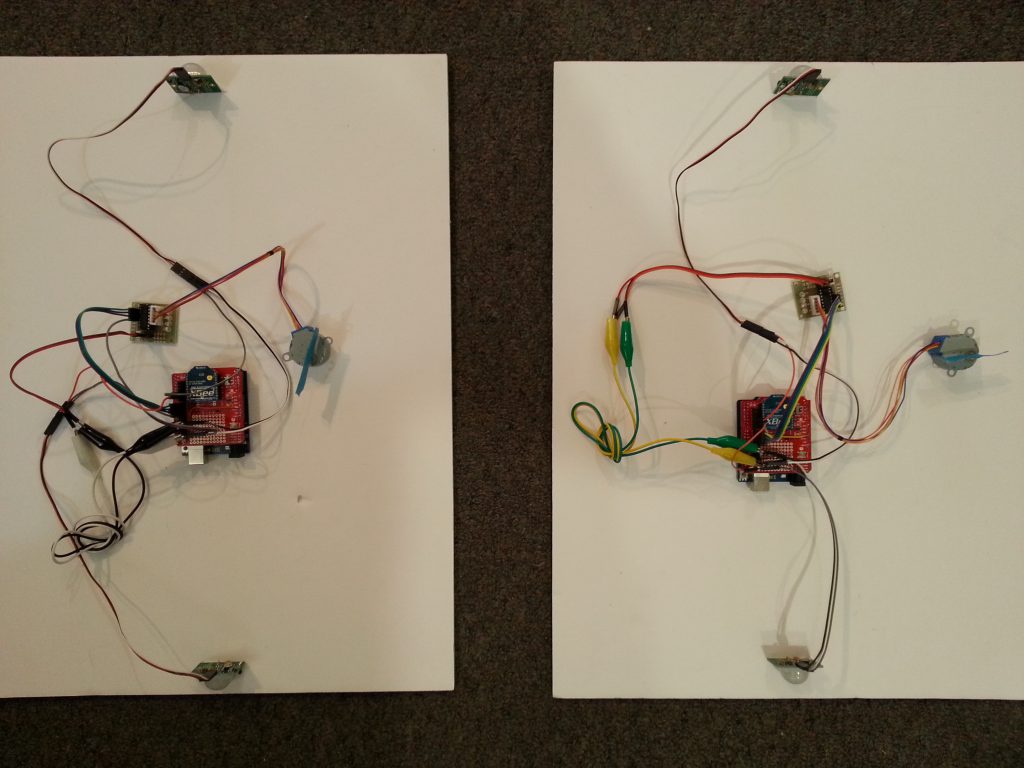
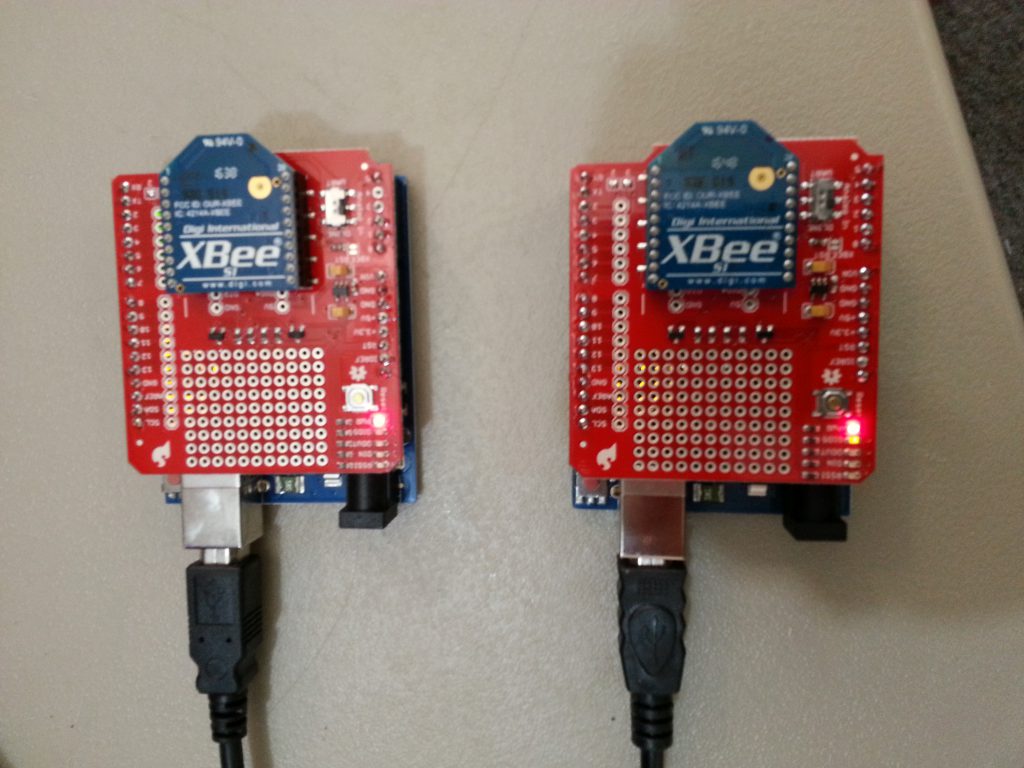
Lighting / Visual / Emotional
Lighting will be an essential component both actually and metaphorically. Bright RGB LED boards are placed inside each C / Borg robot allowing constantly changing, flickering colors to project light of varying intensities onto the ceilings and walls of the Vallensbæk Station DIAS.
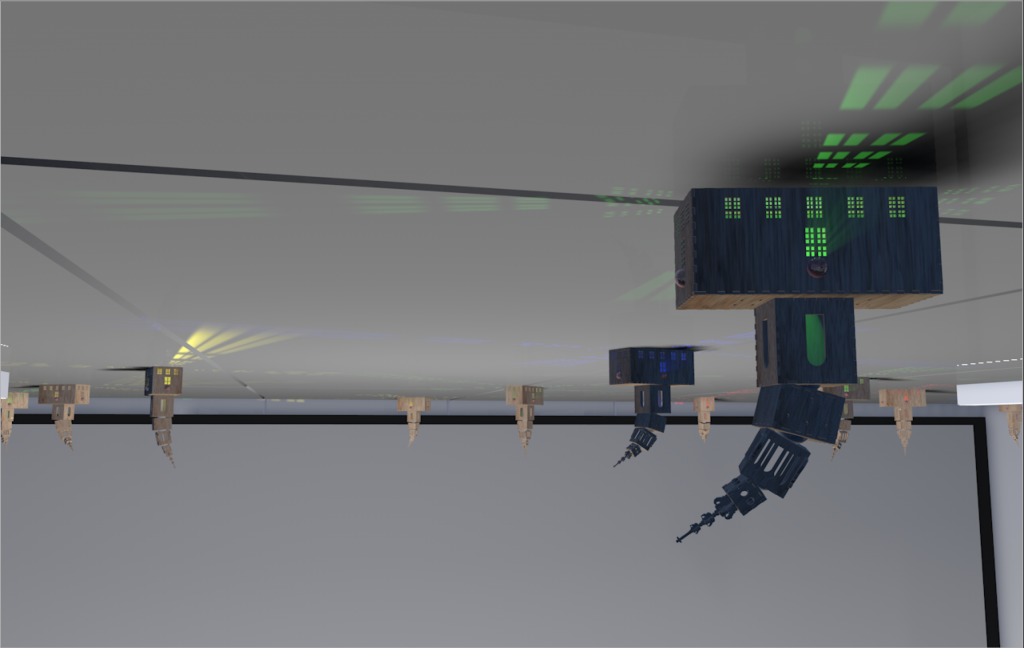
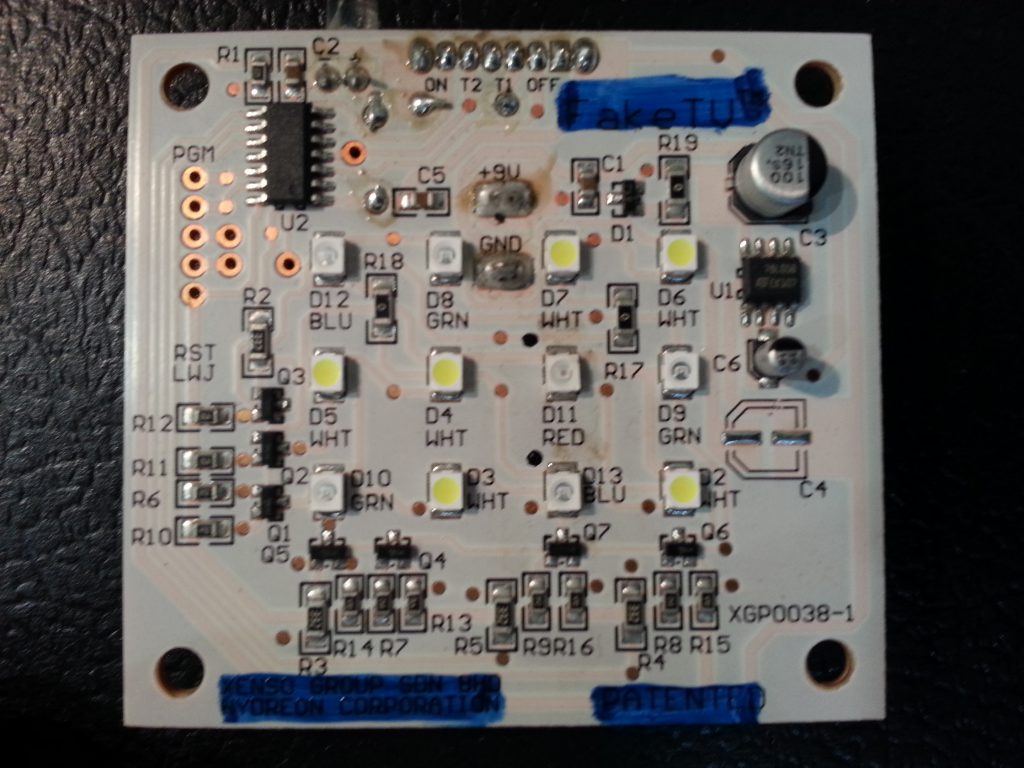
Public Discussion / Participation / Education
One component will be to provide roadmaps for future makers on how to approach prototyping and building robots. A few may be donated to high schools and colleges around Denmark to experiment with and stimulate a conversation about recyclable materials, critical making, robotics technology, and the future of government.
The discussions would involve conceptualization, sustainability issues, advanced manufacturing techniques, robotic control, and artificial life programming techniques.
Other possibilities are making the robots open source, so others can print them with their laser cutters and 3D printers. The software may also be open source, allowing others to experiment and control what they have created.
Local / International Web Outreach
As part of the installation, a couple of the smaller rooms, like the one on the Vallensbæk train Station platform and the one below in the entrance, could have video projectors and closed-loop cameras showing the installation and also allow people to enjoy the work locally. Locally the camera would be a direct feed of a camera that is focused on a natural part of the surrounding green space of the station, like in the bushes focused on a birds nest, allowing those on the platform to watch and see nature space as a projection map onto the walls. International outreach is may be accessible through the Queen and Kings lounge as well as online educational materials made accessible via the web.
While multiple thanks should go to; the DIAS curatorial board contemporary artist, #MortenSøndergaard (DK), curator, assistant professor – Aalborg Universitet, København, and #RasmusVestaargard Chief curator DIAS, in the end, this project was not realized in the space.
While I had received an invitation and contract to produce the work, began hiring workers, and spent about 7K of my own money, the contract was never signed. After many emails and promises to sign the contract, it was never signed. My emails and calls were not returned, and the chief curator Rasmus Vestaargard subsequently left the position.
This left me in the hole for 7K. Neither Morten Sondergaard nor I could ever understand why the contract and commission were offered and why I was allowed to continue to spend my money with promises, though the contract was not signed.
Since then, I have successfully taken many of the ideas produced in this work to other contexts.
However, artists beware that it is best not to trust that contracts will be signed, and caveat emptor; do not spend your own money on commissions in advance of receiving a fully signed contract.
DIAS Digital Interactive Art Space
Vallensbæk Station
2665 Vallensbæk Strand
Artist and Director
Ken Rinaldo: Concept, design, and direction as well as 3D modeling, electronics, and fabrication
Artists Contributors
Dana Lynne Harper (Contingent on the placement of work proposed)
Artists in VR world: (proposed)
Ken Rinaldo, Laura Beloff, Amy Youngs, Trademark Gunderson, Riley Patrick, Danner Seyfer Sprague
Studio Assistants:
Trademark Gunderson: Electronics and programming
Danner Seyfer Sprague; 3D modeling VR
Riley Patrick: 3D modeling, VR
Early Visuals.
